Sidney Crosby put together one of the best seasons of his career last year by leading the league in goals with 44, his highest since the 2009-10 season, and posted his highest point-per-game mark (1.19) since the 2013-14 season. Of his 44 goals, 26 of them occurred in 5-on-5 situations, his most since the 2009-10 season. Nearly all of the even strength metrics confirm his success: shooting percentage, Fenwick and Corsi, PDO, and control of high danger scoring chances.

Fast forward to this season and Crosby is struggling mightily so far, especially in the goalscoring department where he has just six goals on the season with only one coming in 5-on-5 situations. He has already had a 10 game goal drought when the longest drought he had last season was seven games. He is significantly off pace of his career norms and it raises the question of what is behind his regression?
Was Crosby as Good as the Counting Stats Indicate?
As mentioned above, Crosby led the league in goals last season (44), tied for third in 5-on-5 goals (26), and his 1.19 points per game was second in the league only to Connor McDavid. When on the ice, Crosby and the Penguins carried a Fenwick For (FF) of 54.20% and controlled 56.74% of scoring chances and 57.43% of high danger scoring chances(HDSC). Individually, Crosby generated 186 individual 5-on-5 scoring chances, 84 of which were considered high danger, both of which were in the top 15 in the league.
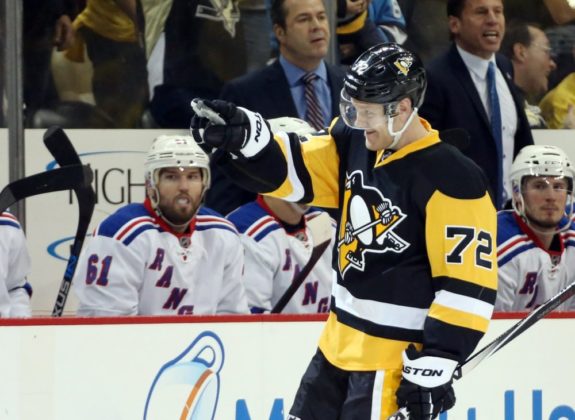
As a center, we tend to measure a player’s value based on how well he drove his lines. Nearly all of the lines he centered for any significant amount of time had positive goal differentials. Crosby also bettered the wings he had the most playing time with – Patric Hornqvist, Conor Sheary, and Jake Guentzel – from a possession standpoint. Crosby’s impact on Sheary was so significant that the latter’s FF rose over 10% when on Crosby’s wing. Based on the metrics, it is evident that Crosby was in fact a very good player last season and that his results were warranted.
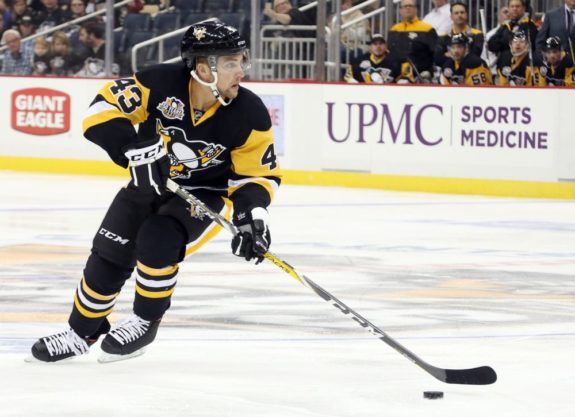
Crosby was a PDO Monster Last Season
Last season the Penguins had a team PDO of 101.2 in 5-on-5 situations when Crosby was on the ice. With a 101.2 PDO, it means that the Penguins were well above average in the category. Broken down, the team shot 8.71% and had a save percentage of .925. However, when compared to the rest of the league, these numbers aren’t that high. In fact, their shooting percentage with Crosby on the ice tied for just 44th in the league among forwards who had at least 1000 minutes of 5-on-5 ice time. Individually, Crosby shot 15.0% in 5-on-5 situations and 17.3% in all situations, well above the league average of 10.75% for forwards and was 11th highest in the league. His 5-on-5 shooting percentage was nearly double the league average of 7.7% and ranked sixth in the league among forwards with at least 1000 minutes of ice time.
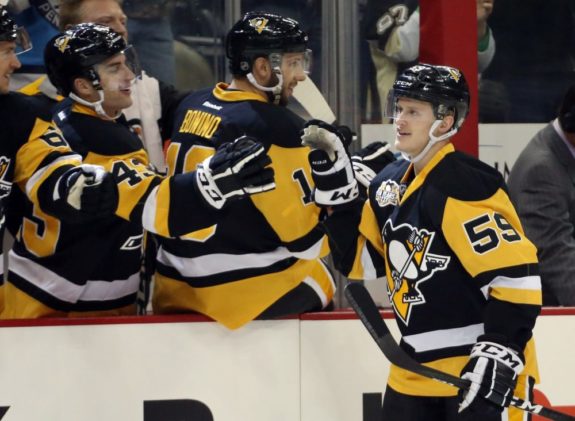
Compared to last season, Crosby’s on-ice numbers this season are down by a considerable amount. At 5-on-5, he is shooting just 2.56% on 39 shots and only 8.7% in all situations. This goes along with just a 92.3 5-on-5 PDO for the Penguins when he is on the ice while the team has had a 101.2 5-on-5 PDO in total this season. This drop in PDO has occurred in both save and shooting percentages when compared to the past few seasons. Because on-ice PDO takes into account the other players on the ice, determining others’ roles in the team’s PDO drop will go a long way in measuring how much of the regression can be placed directly on Crosby.
Crosby’s Linemates Not Picking Up Slack
So far this season at 5-on-5, Crosby has played the most with Jake Guentzel, Bryan Rust, Conor Sheary, and Patric Hornqvist, all with at least 60:00 of ice time while on a line with Crosby. While these players have been on the ice, the team has experienced a regression in shooting percentage when compared to last season. Individually, Guentzel and Rust have both had significant regressions in their personal 5-on-5 shooting percentages while Hornqvist and Sheary’s personal percentages have actually risen this season. Looking at the defensemen used most while Crosby has been on the ice – Kris Letang, Brian Dumoulin, and Olli Maatta – and it becomes even more interesting.
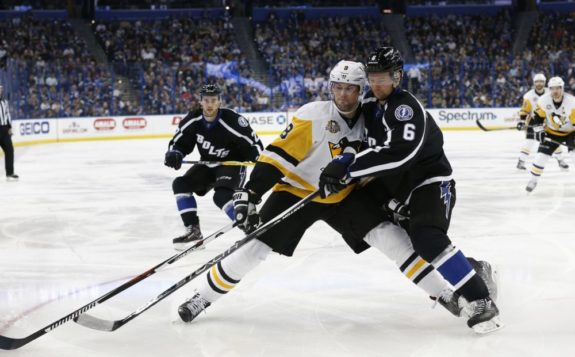
Letang, the Penguins’ number one defenseman, is having one of the worst seasons of his career and currently has no goals at 5-on-5. The team’s PDO while Letang is on the ice (90.8) is lower than Crosby’s while the team has a save percentage of just .858. Meanwhile, Dumoulin and Maatta both have higher shooting percentages than last season and higher PDOs than Crosby’s this season. So what does all of this mean? My thought is that if the players with whom Crosby has played the most with are having down seasons, then part of Crosby’s regression can be placed on those players. However, if their stats have remained the same or even grew since last season, then Crosby’s regression is more of his own doing. In this case, the team is actually playing better when Crosby is on the bench than when he is on the ice, and by a considerable margin.
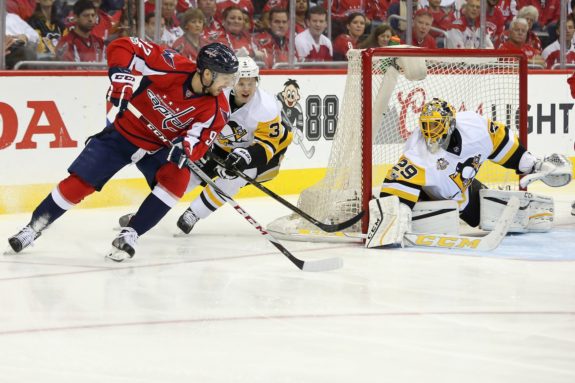
Because all of the players on the ice can impact a team’s PDO, those teammates he shared the most ice time with have to be taken into account. While he has been on the ice, his linemates haven’t played that much worse than they did last season. Only Guentzel has had a significant regression in shooting but that has certainly affected the team’s PDO when combined with Crosby’s regression. I feel that a big reason for the PDO regression is how often he has been playing with Kris Letang, with over 160 minutes of shared 5-on-5 ice time so far this season.
With Letang off to the worst start of his career, it has had an effect on every else on the ice, especially when defensive breakdowns and low save percentages lead to a bad PDO. Letang has always been known as a defenseman who excels in the offensive aspects of the game. He has always been an excellent skater, which has allowed him to make up for his aggressive play in the offensive zone. However, as he has aged, this skating ability has begun to regress and he is becoming more of a defensive liability and poor decision-making has led to many odd-man rushes against his goaltenders.
Is Crosby’s Season Just a Continuation from the 2017 Playoffs?
Despite winning consecutive Conn Smythe Awards the past two years as playoff MVP, from the 2015-16 playoffs through the 2017 Stanley Cup Final, Crosby’s on-ice numbers have dropped in nearly every category. It is easy to compare these two playoffs because he played in the same number of games both years and had within 21 seconds of 5-on-5 ice time between the two postseasons. Between the two years, Crosby’s on-ice Fenwick dropped from 56.77% to 46.79% and the team’s scoring chances percent dropped from 57.25% to 48.86%. I feel that paying attention to Crosby’s playoff metrics is important because it is an easy way to compare his play against higher levels of competition. It also makes for an easy comparison because the team around him remained relatively the same and therefore limits the amount of fluctuations and can measure Crosby’s regression fairly accurately.
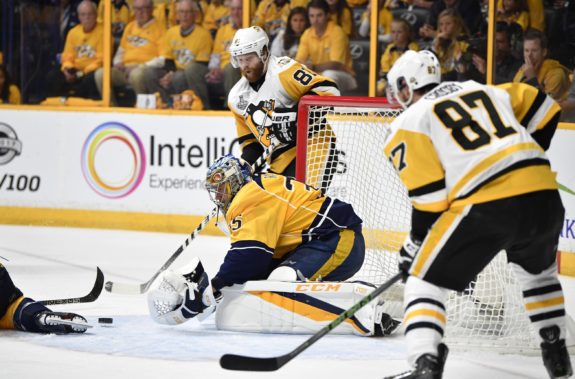
Continues to be put in Situations to Succeed
Crosby has continued to receive advantageous zone starts under head coach Mike Sullivan with his non-neutral zone starts increasing each of the past three seasons. For the 2017-18 season, he is starting in the offensive zone 62.67% of the time during 5-on-5 play, his highest rate of the past five seasons. His zone start percentage is important because the more offensive zone starts a player receives, the quicker the puck can be put on net. With no regression in this metric from last season to this season it also removes that element as a potential reason for Crosby’s decline in production.
Is this the Beginning of the End for Crosby?
We now know that the physical peak for the typical NHL forward is around age 28 according to a study done by the CBC in 2015. Crosby turned 30 in August and is on the wrong side of that peak. Add to that the injuries he had earlier in his career and the amount of hockey he has played the past two years (209 games not including the preseason) and it makes sense that he could be simply slowing down. There are trends within Crosby’s underlying numbers to support this. His FF% is currently regressing for the third consecutive season, dropping from 55.86% in 2014-15 to 52.31% this season. The shots taken while Crosby has been on the ice have also dropped for the third consecutive season while the team’s goals for percentage, high danger goals percentage, and PDO are on-pace to drop for the second consecutive season. These regressions become even more alarming when factoring in his postseason statistics the past two years.
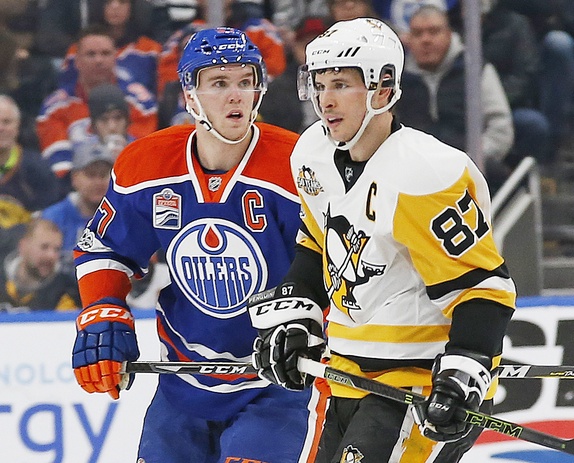
I believe that there is strong evidence to support the theory that Crosby could be in the early stages of his decline as an elite player in the NHL. He is currently on-pace to set career lows for an 82 game season in goals and points, both in total and at even strength. He is also on-pace for his fewest 5-on-5 shots and individual scoring chances since the 2009-10 season when Natural Stat Trick began recording this stat. Crosby shouldn’t be written off yet as an elite player, but he will have to begin changing his game in order to stave off a drastic decline. One way to improve this season is to shoot the puck more. A higher volume of shots, even with a low shooting percentage and poor talent around him, can yield a higher output. Crosby is still one of the most electric players in the game and has always worked to improve his deficiencies and if he is able to rebound from this poor start, it shouldn’t be a surprise to anyone.
*All statistics came from Corsica, Hockey-Reference, Quant Hockey, and Natural Stat Trick